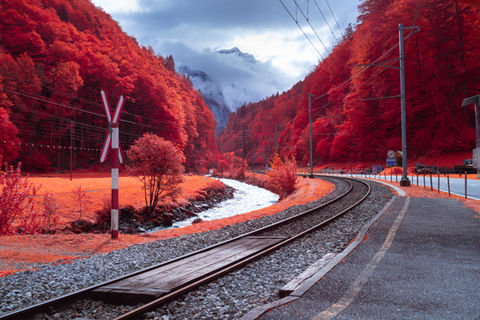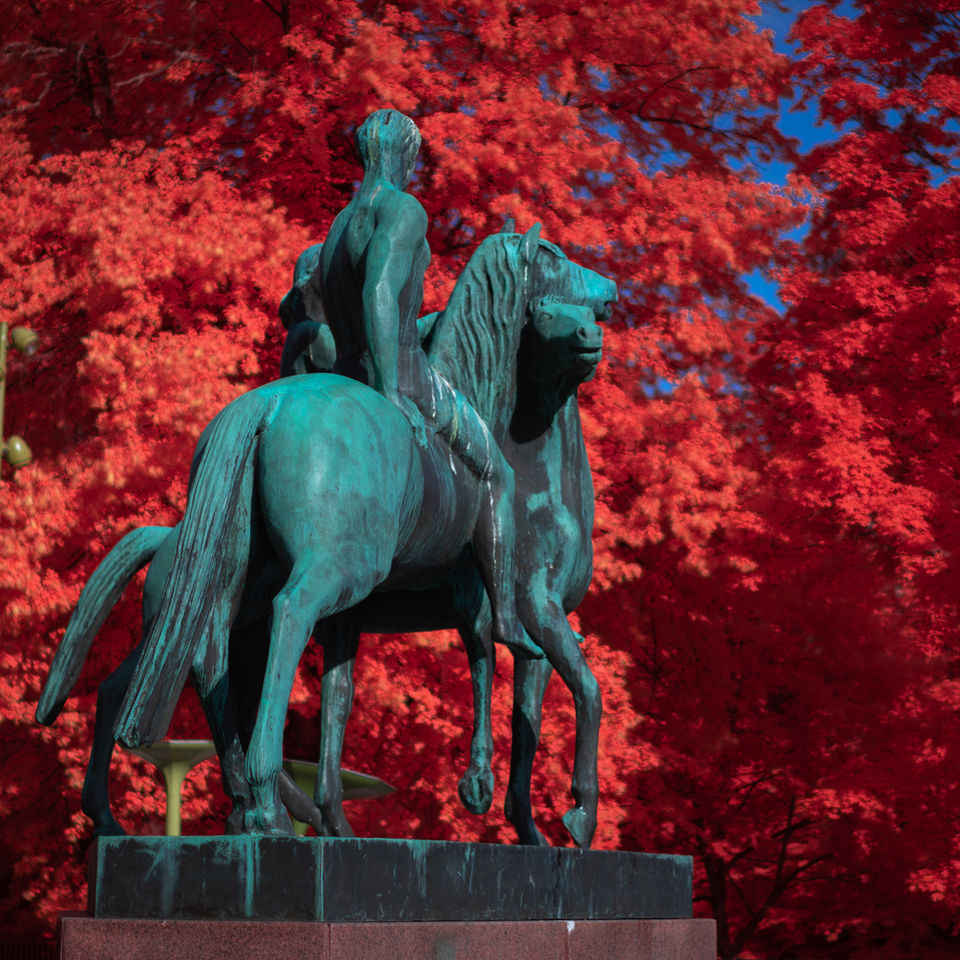This filter (made by Kolari Vision and developed by Yann Philippe) was developed for 'full spectrum' (or 'Two Spectrum') converted cameras to provide results similar to the classic 'Kodak Aerochrome' film more easily.
Compared to 590nm
With a bit of processing the 550 (orange), or 590nm (red) filters are capable of providing red foliage, like Kodak Aerochrome film, so how does the IR Chrome filter differ? The main aspect that makes this filter special is the lack of processing required to get this look. No channel swap. Apart from streamlining your workflow this also means you get to see this look on the 'Live-View' screen, or even better (with mirrorless) - the EVF. This will make the IR Chrome filter a game-changer for many photographers! After processing the results from a red filter you'll noticed that the sky is much darker by comparison and this could allow images to be exposed brighter, to brighten the red. This is happening because a red (590nm) filter lets in much more infrared light than an IR Chrome does. Whether this is desirable either way will be up to you. I like both.



White Balance
The above IR Chrome image involved using the following WB and hue settings in ACR:

Here's what the image looks like when using various WB settings:




Yann Philippe tells me that you can achieve something similar to the red foliage look in camera by not setting the WB on a grey card and instead using some lightly cool tinted grey (greenish or blueish). I have yet to try this, but thanks Yann for the pro tip! :). That said - Auto WB already looks great and when shooting RAW the processing is super simple. So although you can fine tune the settings, you don't really need to do it when shooting.
Colour Fringing
The below image is a crop (and a super crop) of the above IR images to show colour fringing on the edges of fine detail like leaves. Since 590nm images require a couple of processing steps to reach the Aerochrome look, one of the side effects of this is fringing on the edges of IR reflective objects. Here's how the IR Chrome filter differs in this regard:

Hue Shifting IR Chrome To Emulate 590nm
You can emulate Aerochrome pink/red IR images with 590nm by hue shifting yellow to red, but what about the other way around? This works pretty well when editing the RAW, so another improvement over 590nm and provides a little less colour fringing than going for red foliage with the 590nm.

Other Colours
False colour IR (like 590nm) images are dual-tone. They have two distinct colours (yellow and blue by default, after the channel swap). This filter is very different however. To a lesser extent, most colours display how they do in visible light, which gives the IR Chrome a pretty special look!




These colours are a huge benefit to the IR Chrome in my opinion. It's not the same as what you get in Kodak Aerochrome images (from what I have seen). The colours are much more distinct and closer to reality with the IR Chrome. Some photographers may not like the variety of colours you get here, but to me this gives IR images an extra dimention and infuses them with a touch of reality. It's a different look and something that can potentially compliment (rather than replace) the dual-tone look of 550 or 590nm filters.
From the above image you might think that the IR Chrome images can get quite busy, but I didn't find this in a majority of the images I took. See the gallery below as a more broad demonstration of filter's typical look.
Infrared HotSpot Performance
Hotspot performance is something that bugs me... a lot! So does this filter produce a different amount of hotspot on the same lens? See for yourself...




All of the above images were taken on the Zeiss FE 35/2.8 lens at f/16
Infrared Hotspots are mostly caused by the lens. The issue is not related to lens flare (these images were looking away from the sun). To read more about hotspots or to see my accurate testing of over 100 lenses click here.
Kolari have make some of their filters with an "Anti-Reflective" coating, which helps to reduce hotspot, although it's much more effective on internal filters. The IR Chrome filter comes with this coating, but I think the main reason why it has significantly less hotspot than any of the normal IR wavelengths is that it passes more visible light than IR. Hotspot does still occur with the IR Chrome, but it's much less than 590nm, which will be hugely beneficial for many photographers!
This feature will allow many poor performing IR lenses to shoot colour infrared with confidence in harsh lighting conditions again. This Zeiss 35mm lens, for example is now usable @f/11, where before I wouldn't have touched it with a barge poll even @f/4. It's not possible to underestimate how much of a game changer this feature alone is!
Focus Offset
Most lenses focus at a different distances with infrared compared to visible light, but in the case of the IR Chrome I didn't find any offset at all. Perhaps this is related to the visible light the filter uses. This made me wonder why there isn't any issues with the colour channels matching up, but hey, if it works...

The above images show infinity focus visible light, IR and the IR Chrome. This displayed consistently on several lenses. The focus point may not quite look like infinity here, but I can confirm that the focus is at full lock for both the colour and the IR Chrome.
Image Gallery
Here are some of the images I have taken with the IR Chrome over the last week:
Full spectrum DSLR users may be effected by this if their converted camera's autofocus has been calibrated for IR (on a certain lens). However since 590nm and 850nm also focus at different distances anyway this shouldn't be much of a shock to anyone.
This effect only shows up to me because I use a lot of manual focus lenses. Mirrorless cameras are not affected by various wavelength focus offsets due to their focus systems working on the sensor plane.
Final Words
If there's one down side with this filter it would be price. There really aren't many other issues with it. If you're happy to buy one big size and use step-up rings for your various lenses then it's not too bad. However, I don't like doing that, so the price can feel rather high when you think that you might need a few of them. This is especially true if (like me) you don't live in the US and you need to factor in international shipping, customs and tax. For this reason I'm limiting myself to one right now and that was a difficult decision.
Despite the above paragraph - If this thing just made IR images with red foliage it would already be worth it, but the other benefits it has over 550/590nm are also pretty big, if not bigger:
-
No colour fringing - nice
-
No focus offset - cool
-
Inclusion of various other colours - pretty amazing
-
Drastically reduces hotspot - Absolutely stunning!
All of those points are on top of the fact that you get to see the Aerochrome effect in Live-View (or on the EVF for mirrorless)!!
If you have a full spectrum (or Two Spectrum) converted camera and you like the red foliage (Aerochrome) look then you will love the IR Chrome filter! This filter makes the full spectrum conversion even more compelling. Anyone considering getting a camera converted should think much more carefully about going for a straight IR conversion as you will be locked out of using this amazing filter!

















